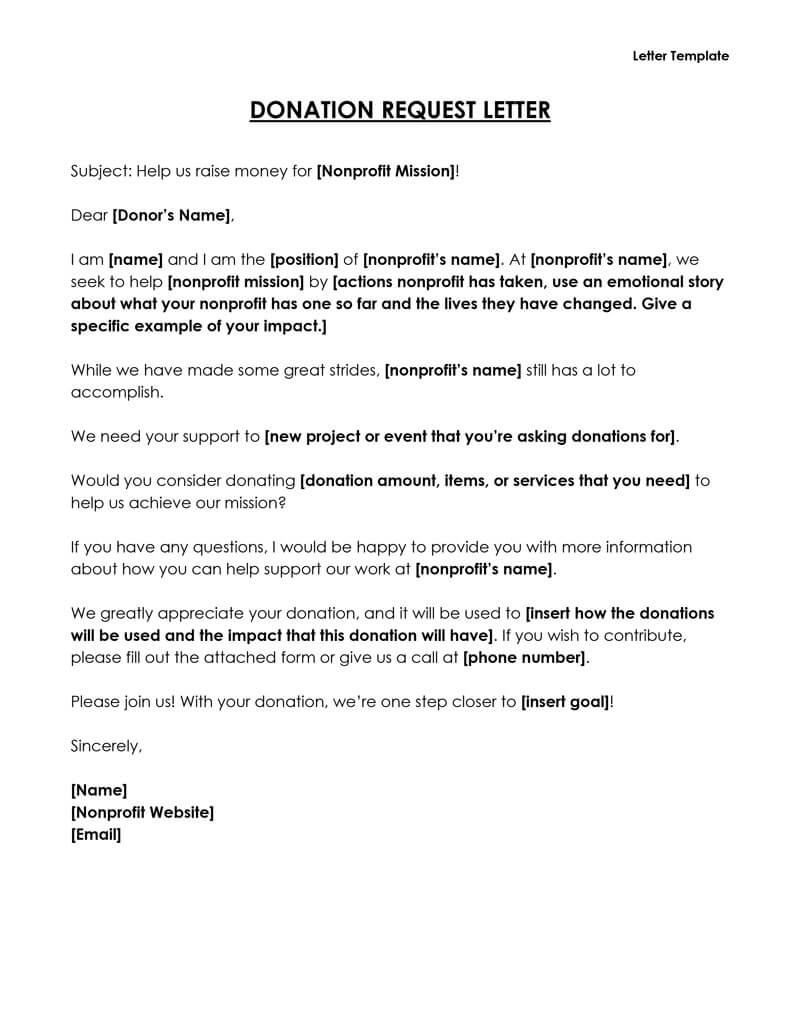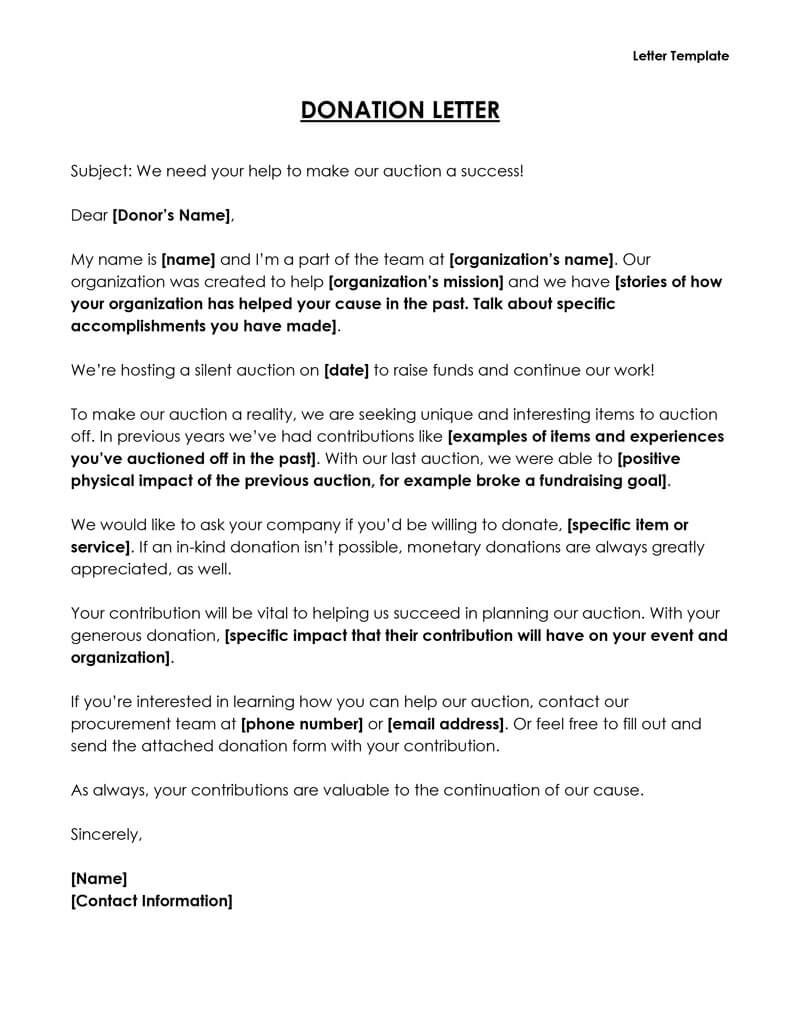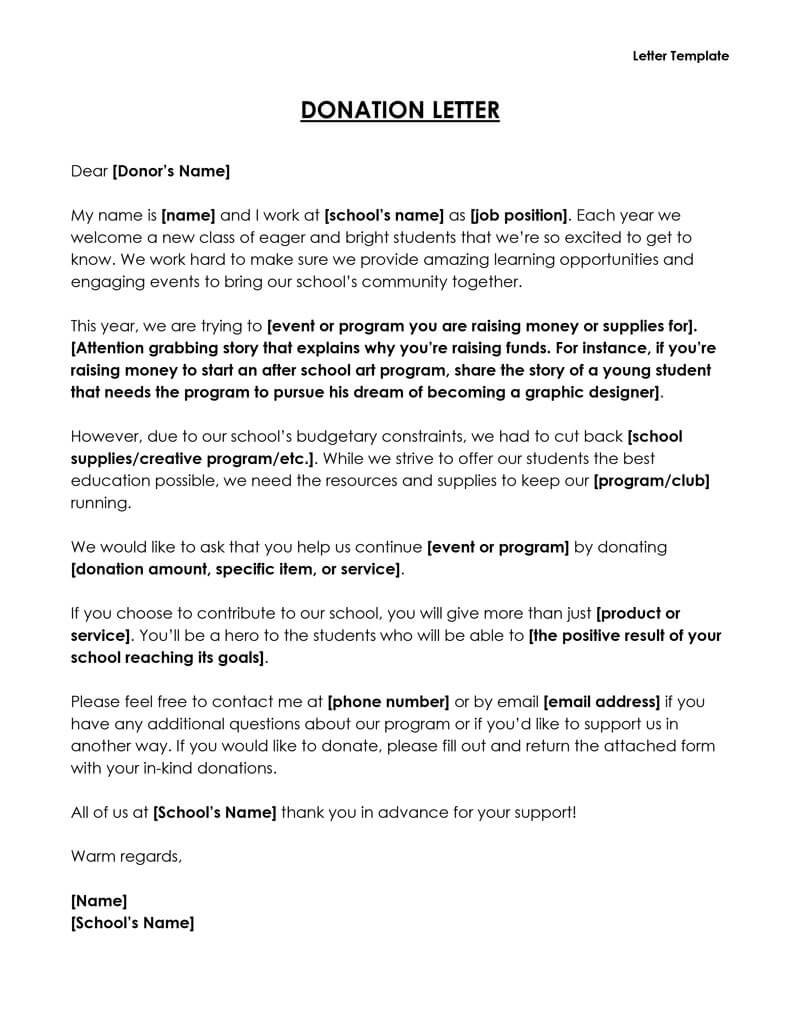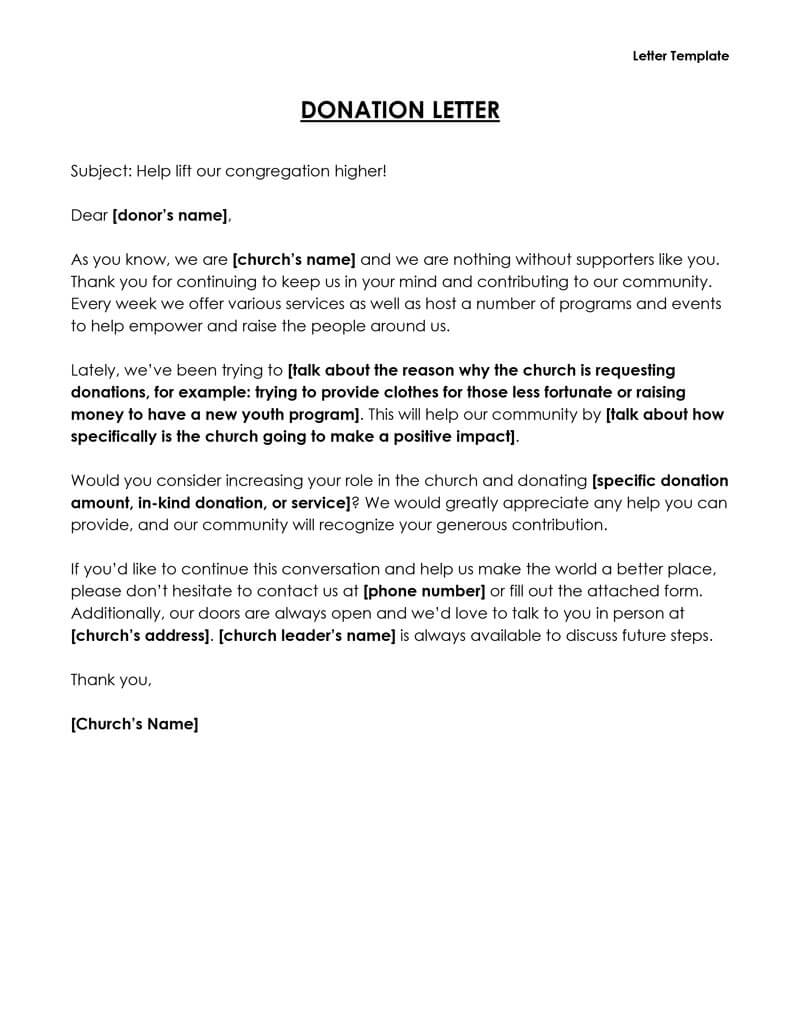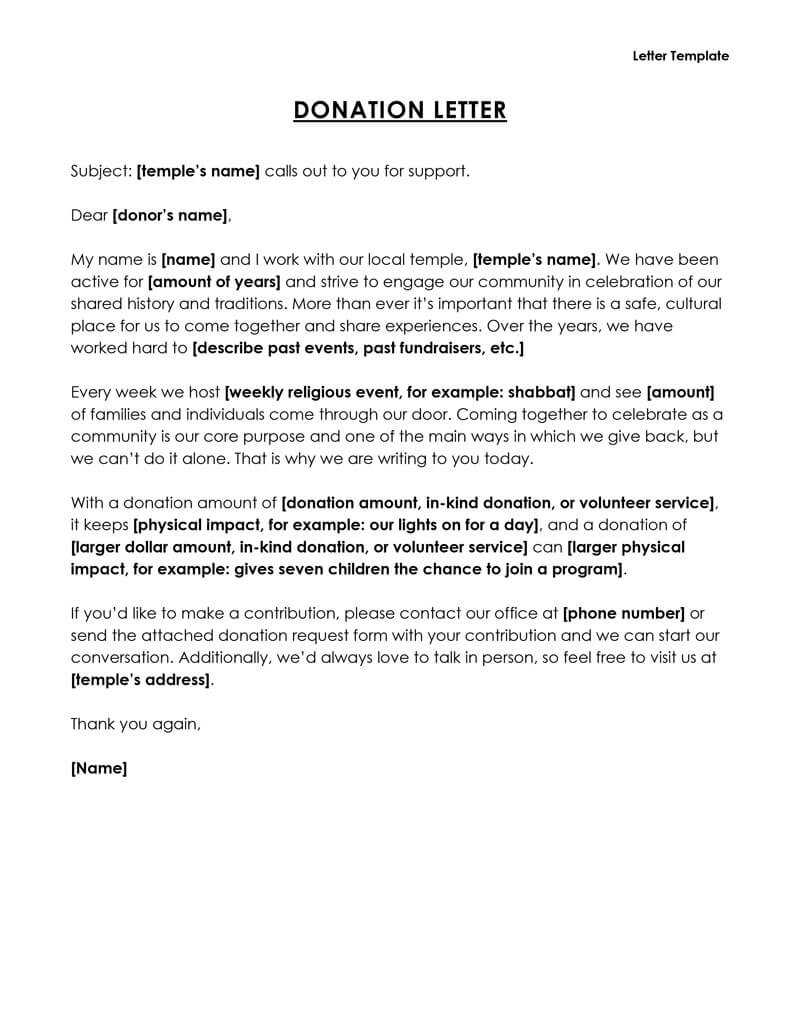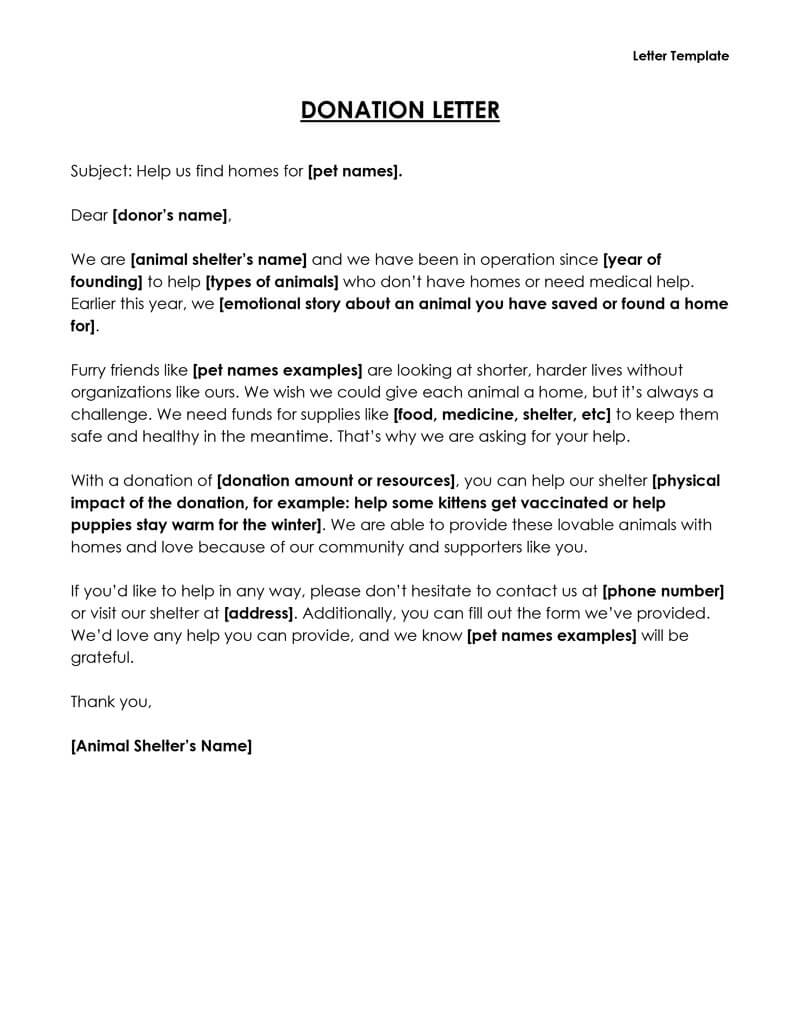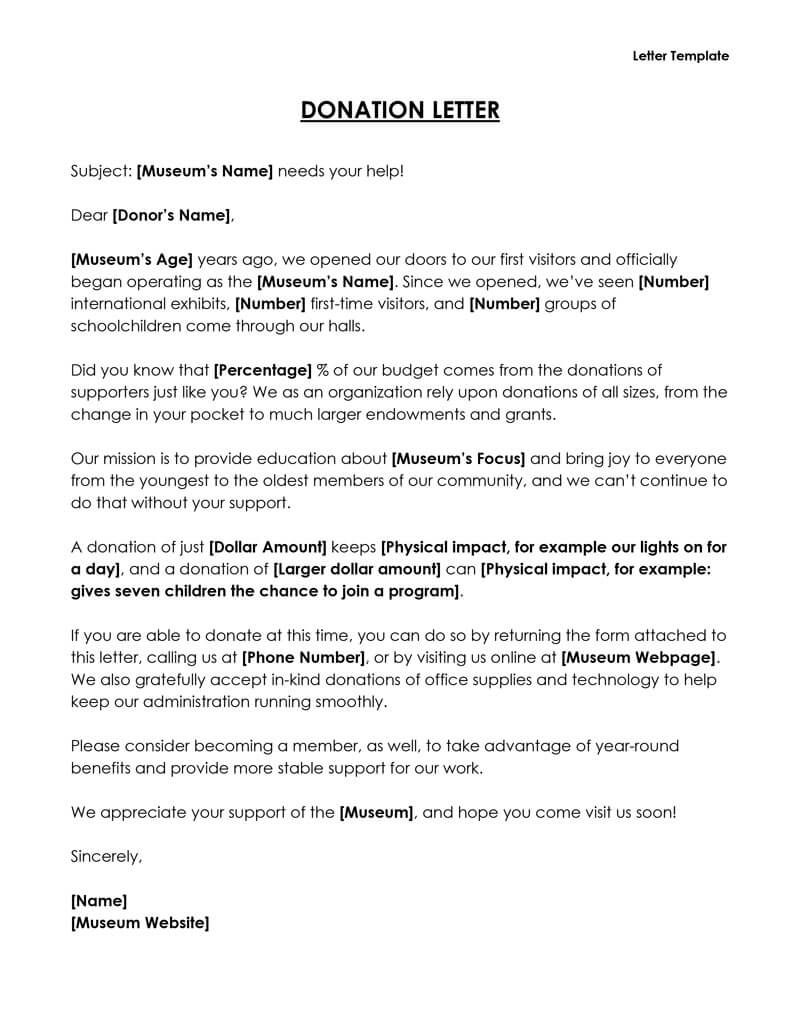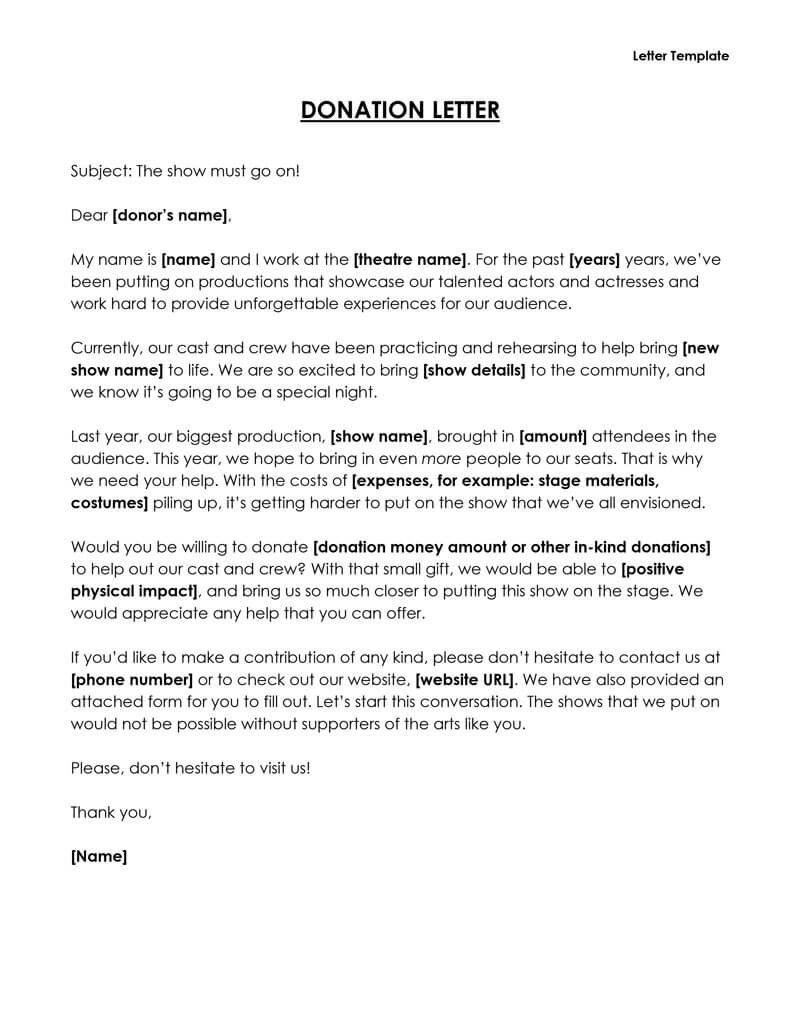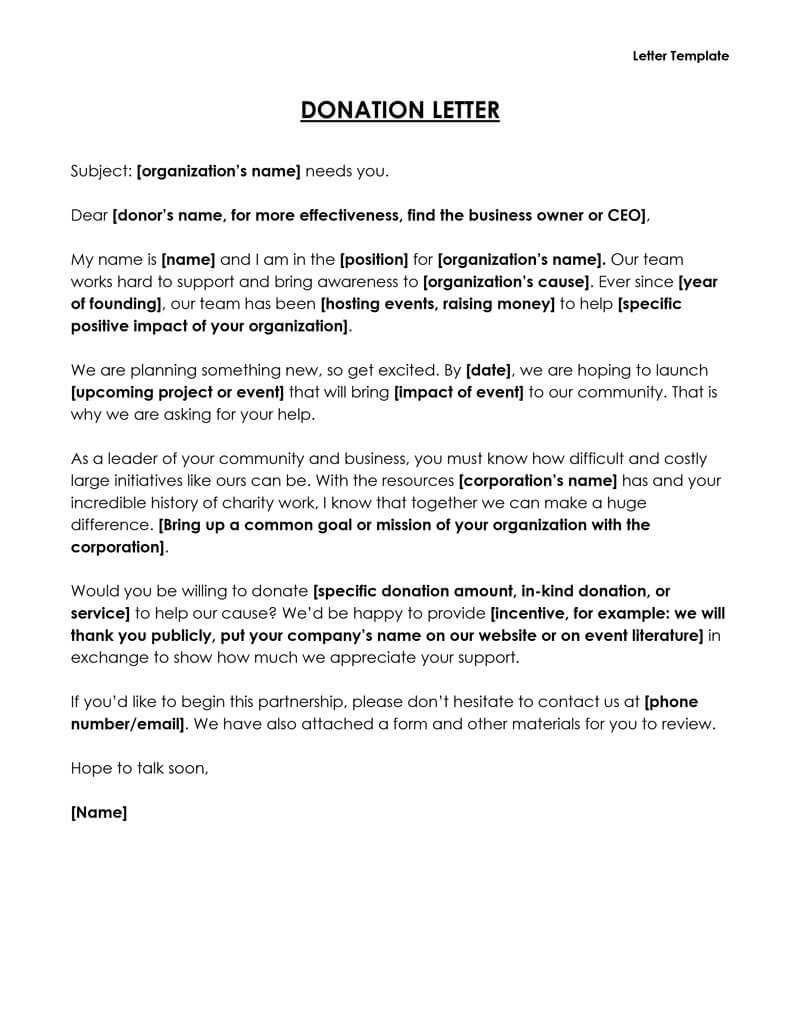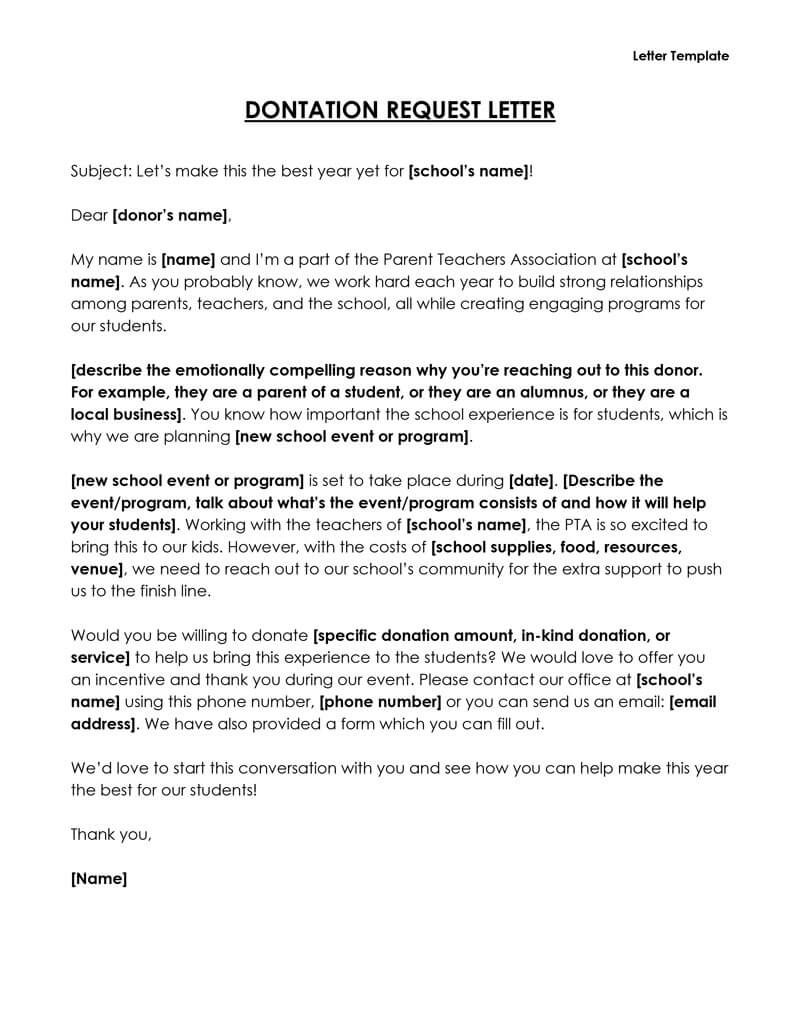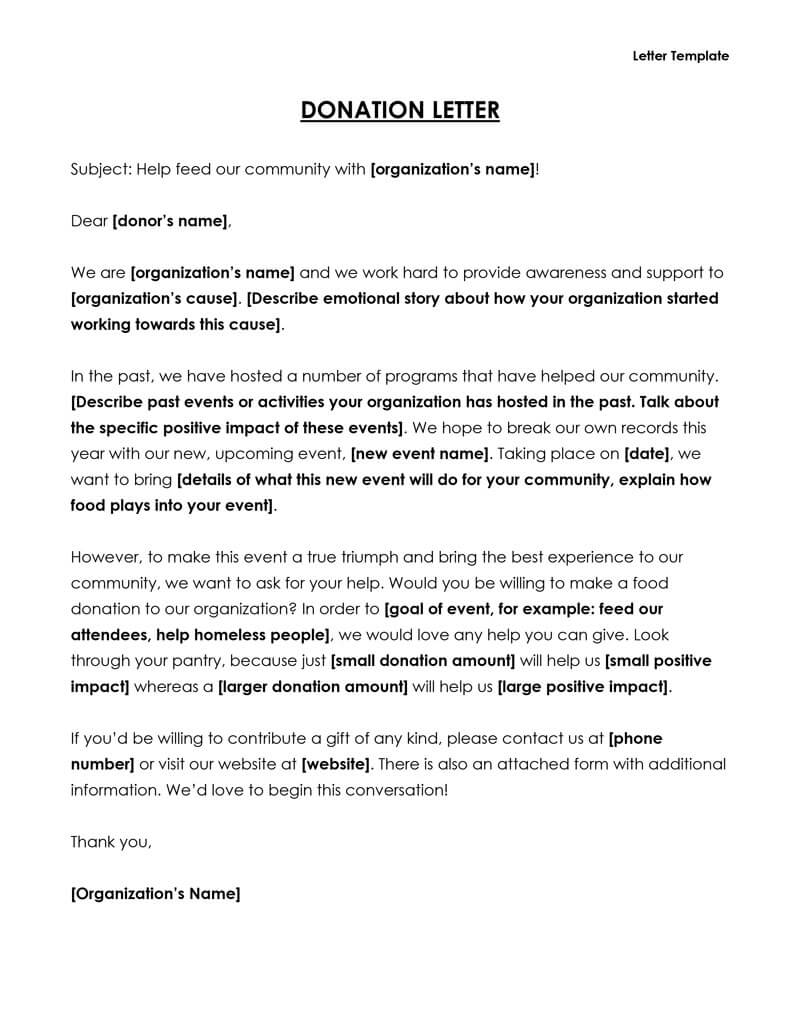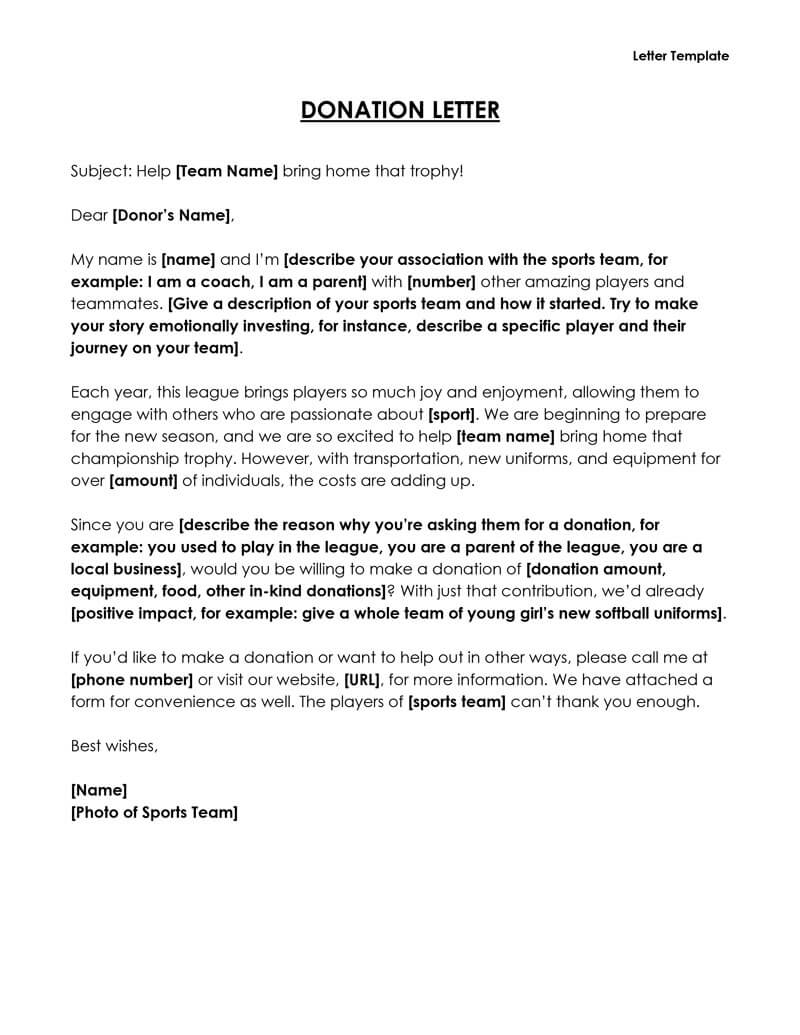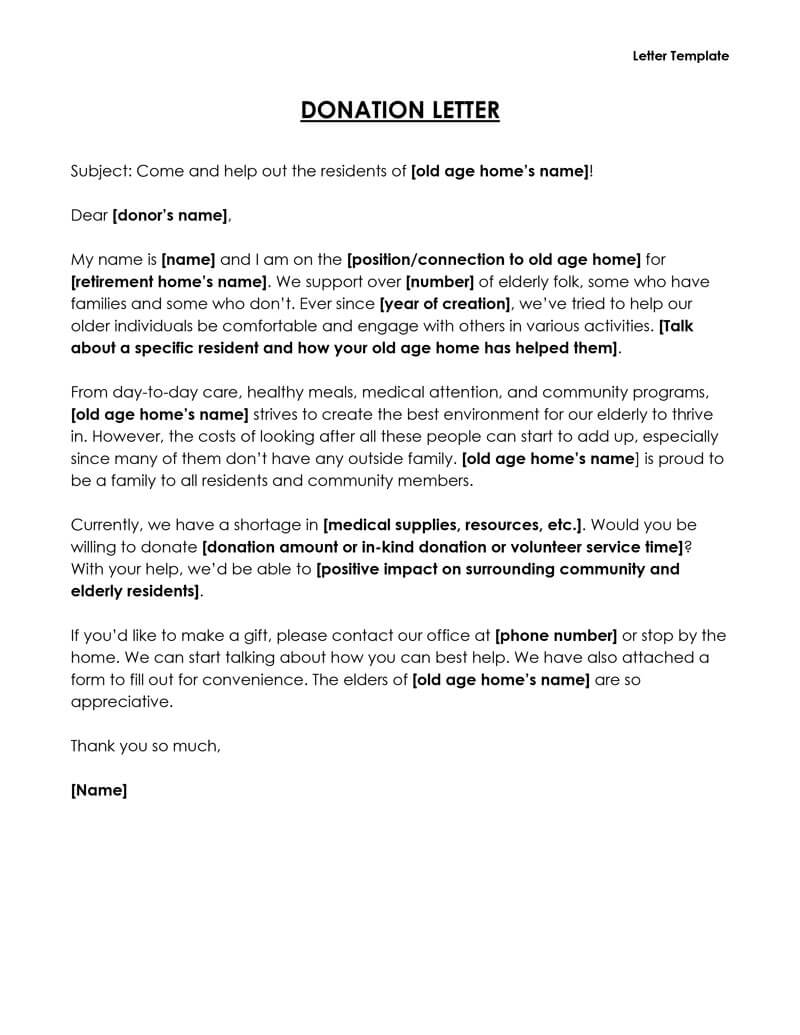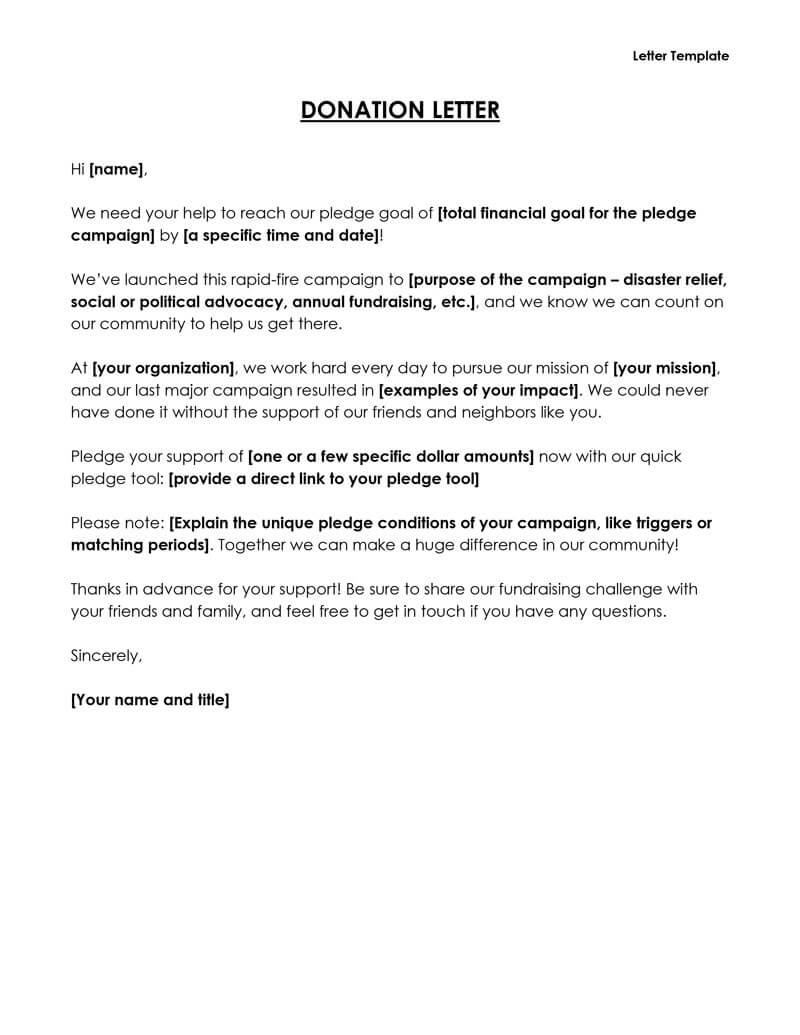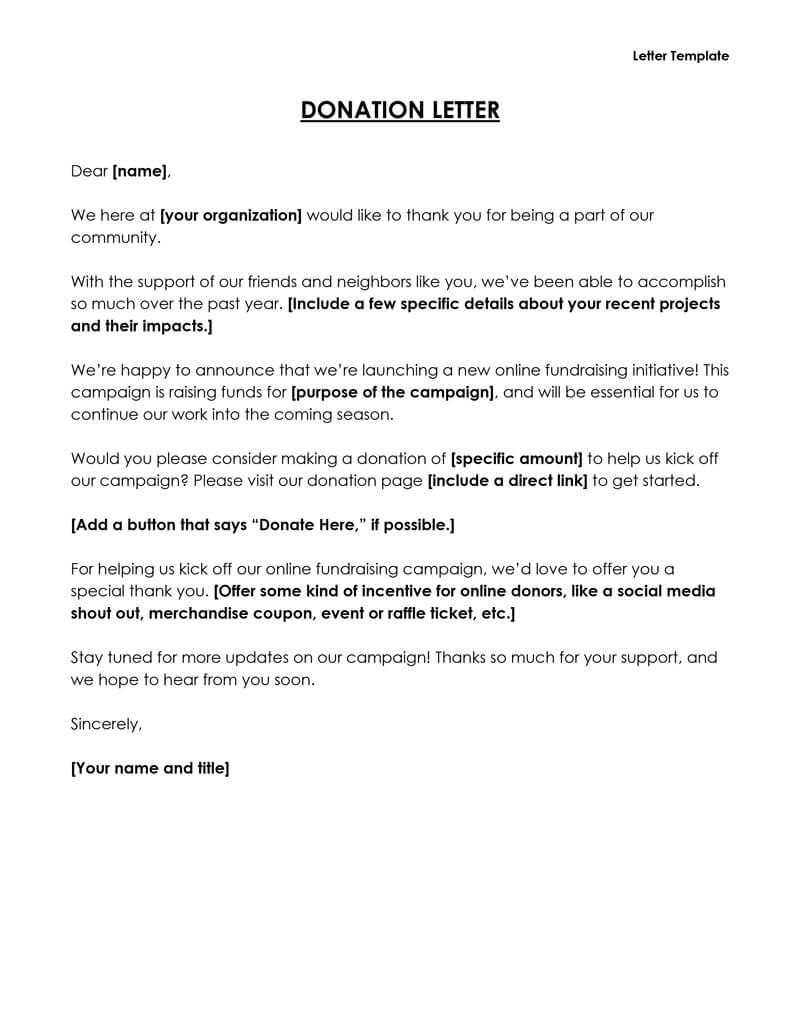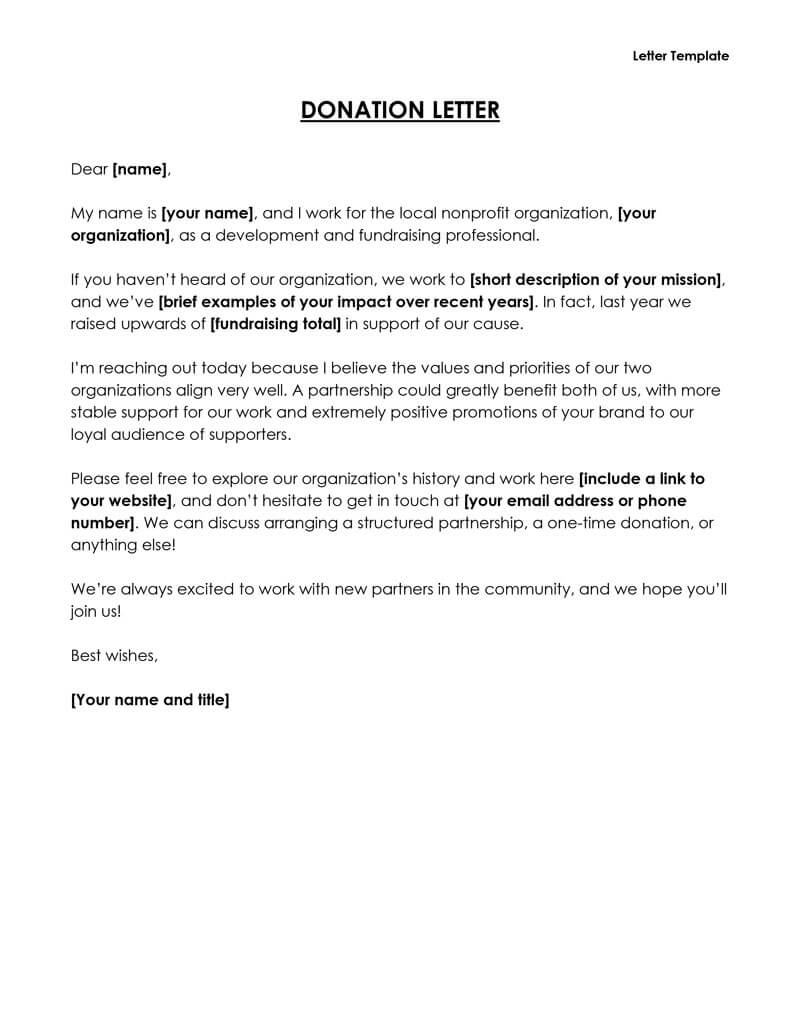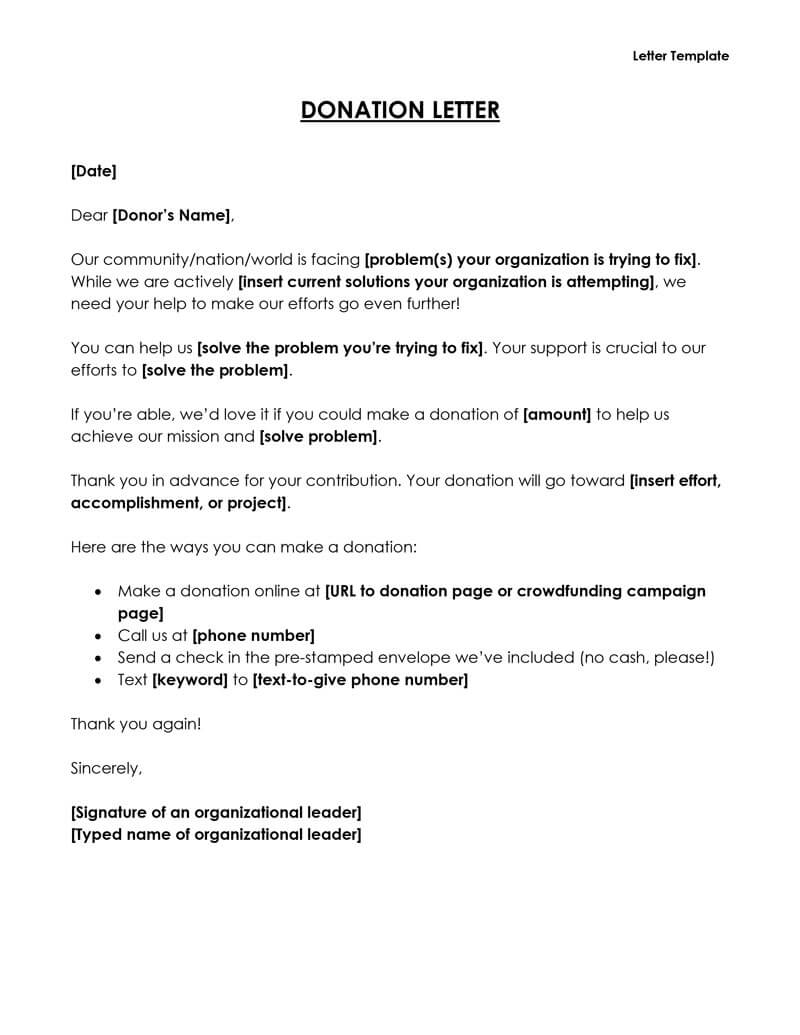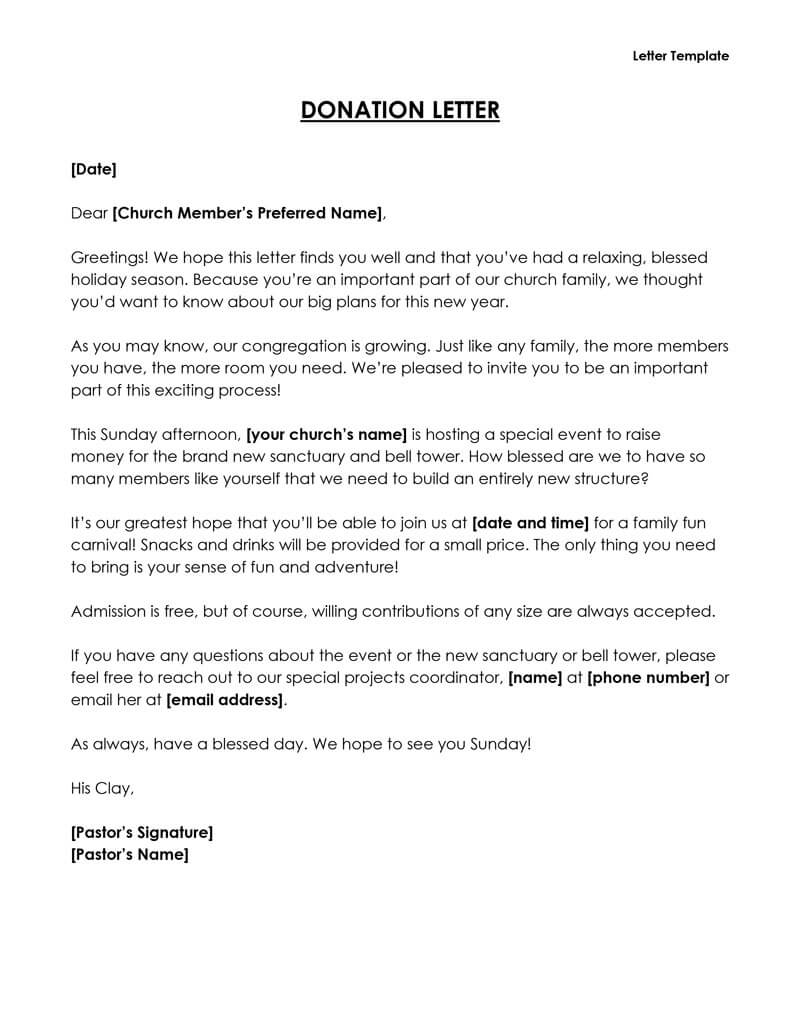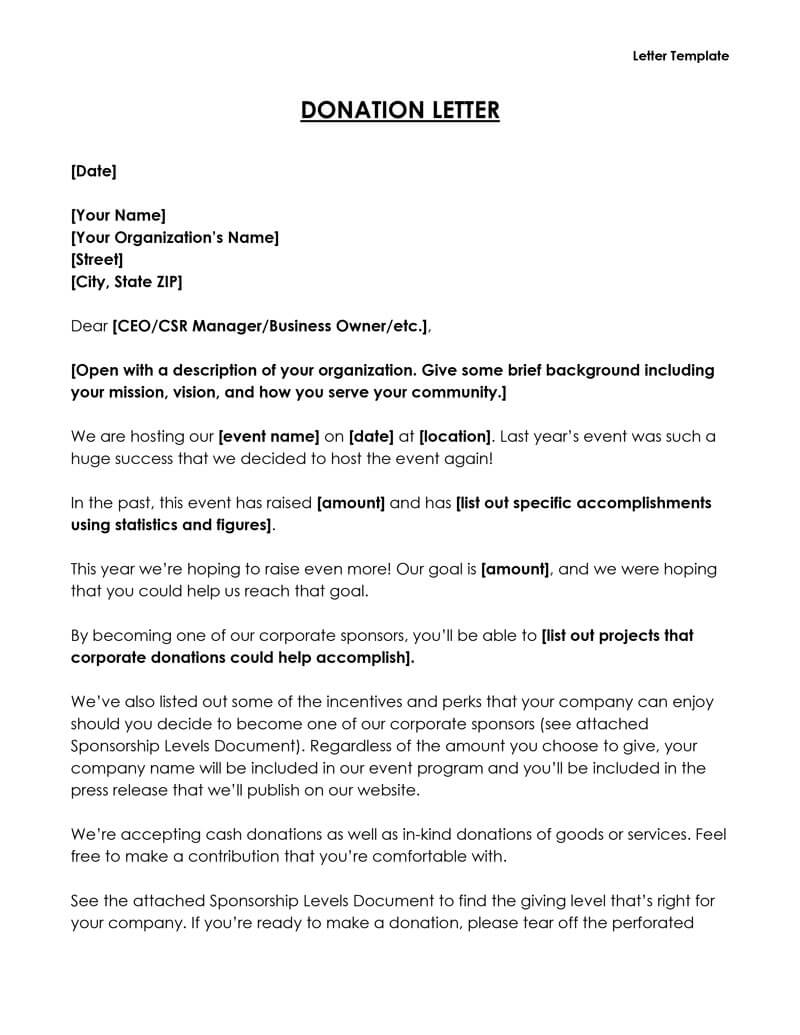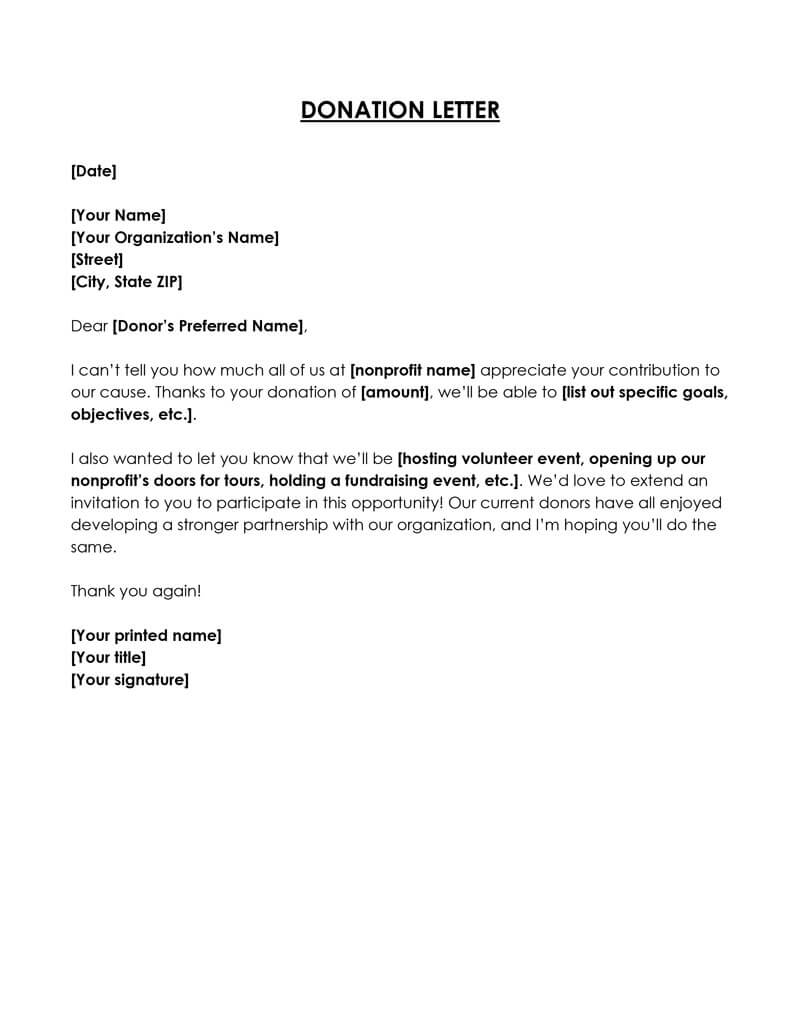Appeal letters are written communications that aim to persuade individuals, businesses, or organizations to contribute financially to a cause, charity, nonprofit organization, or fundraising campaign.
A donation request letter is an official document written by a representative, such as a director, fundraising manager, or volunteer, of a non-profit organization or charity. They often include details about the specific project or program that requires funding, the goals or outcomes the donations will support, and any incentives or benefits offered to donors. They may also provide information on how to make a donation, such as a link to an online donation platform or instructions for sending a check.
The primary objective of a donation appeal letter is to inspire the recipient to take action and make a contribution, emphasizing the importance and urgency of their support. If you want to convince the recipient to donate money, goods, or services, you must know how to write an effective appeal letter.
Therefore, this article will provide a comprehensive guide to preparing this letter. It will also focus on what to include, tips for writing effective appeal letters, and the different types of request letters. In addition, you will have access to free samples and templates.
Donation Letter Templates
You can download the following templates for free:
The Importance of Donations Appeals for Nonprofit Organizations
Donations play a vital role in the success and impact of nonprofit organizations. They provide the necessary funding to support programs, initiatives, and daily operations. By relying on donations, nonprofits can fulfill their missions and work towards their goals, whether it is providing education, healthcare, environmental conservation, or addressing social issues.
Here are some key reasons why request letters for donations are essential for nonprofit organizations:
Fundraising success
Letters requesting financial help contribute to the overall success of your fundraising efforts. They serve as a fundamental tool for generating financial support and helping your organization achieve its fundraising goals.
Increase awareness
One of the main goals of using these letters is to explain the mission and vision of the organization to potential donors. These letters clearly articulate why you need the support and the impact these donations will have. You can share stories of people or communities that you have helped. This will make the donors aware of the work you do and the cause you want them to support.
Build relationships
A letter to request financial contributions makes it easy for donors to connect with non-profit organizations. Through thoughtful and meaningful communication, you can establish a connection, demonstrate gratitude for past support, and cultivate long-term partnerships. Building relationships is essential for securing ongoing support and fostering donor loyalty.
Cost-effective
Letters are an affordable and practical way for non-profit organizations to seek funds. If you are a charity organization looking for donations, you can send letters in bulk to potential donors without incurring extra costs.
Increase donor base
Donation request letters can reach a wide audience, allowing you to expand your donor base. By targeting individuals, businesses, or organizations that align with your cause, you can attract new supporters who may become recurring donors or advocates for your organization.
Measure success rate
Appeal letters contribute indirectly to measuring the success of fundraising events. By tracking the response rate to the letters, you can assess the level of interest and engagement from potential donors. Furthermore, monitoring the conversion of recipients into event attendees or contributors provides insights into the effectiveness of the letters. Additionally, comparing the funds raised through the letters to the overall fundraising goal helps evaluate their impact.
Finally, by examining donor engagement and retention, you can gauge the long-term effectiveness of the appeal letters in fostering ongoing support. While not a direct measurement, analyzing these factors provides valuable data to assess the success of fundraising events.
Did you know? Approximately 36% more non-profit organizations receive donations, contributions, and other types of support when they send personalized request letters than when they do not, according to Network for Good.
How to Write an Effective Fundraising Request Letter: A Step-by-Step Guide
Letters are among the most effective ways of asking for financial support. Here are steps on how to prepare an effective letter:
Step 1: Start with a greeting
It is crucial to start with an appropriate, personalized greeting. Greetings are an effective way of encouraging potential donors to read your letter. They are also a way of showing respect to the recipient. Therefore, you should start your letter with a formal salutation such as Dear [donor’s name].
Step 2: Explain the mission of your organization
It is important to mention the mission of your organization. This allows the recipient to understand what your organization is striving to accomplish. Additionally, a well-explained organizational mission helps donors relate to the organization and be compelled to donate and participate in your charity events.
Step 3: Describe the current project or campaign
After stating the mission of the organization, it is necessary to describe the current charity projects, campaigns, and events for which you are seeking donations. Be clear about the goals, objectives, and timeline of the project, and explain how the funds will be used. Such information is crucial as it allows the donors to know what to donate and how to participate in these events.
Step 4: Provide compelling details
Besides mentioning the current projects, it is necessary to give details about these campaigns. You can include statistics, success stories, a backstory, or even testimonials from those you helped. It is all about making a compelling case for your donation request by showing the potential donor the benefit or impact of your cause. That means that you should not only focus on the current projects but also on the reasons why donors should support your work.
Statistical Insight: A study shows that you have a 75% chance of receiving a donation if you indicate the impact a donation will have on your cause. Therefore, it is necessary to include a tangible impact statement such as “Your donation will help shelter more than five homeless individuals.”
Step 5: Specify the amount you need
Make sure to specify how much money your organization requires in the letter. You can mention how these donations will impact your cause.
For instance:
“We are requesting a contribution of $100 to help fund our water project.”
Ensure that you also inform the donor on how they can make the contribution. You can provide a guide on donating online, through the mail, or over the phone.
Tip: Your tone should always be respectful and full of gratitude. It is all about showing your appreciation to the donors for their consideration.
Step 6: Add a call to action
It is important to include a call to action in the letter. Once the donors know the reasons for their donations, the resources, or the amount needed, you must encourage them to take the next step. You can invite them to an event or volunteer opportunity. You can also include a deadline to encourage donors to make their contributions as soon as possible.
For example:
-Please join us for our upcoming online fundraising event on April 11 to gather funds for Hope Children’s Home.
-We are looking for volunteers to assist with tree planting on Tuesday next week in order to save the environment.
-Do not miss your chance to make a difference – donate towards our cause now to support us.
Pro-tip: It is necessary to customize and tailor your call to action to complement your current campaign. For instance, you can urge potential donors to subscribe to an automatic monthly contribution program if you have a recurring donation campaign.
Step 7: Express gratitude
When concluding your letter, thank the donors for considering your request. Also, thank them for their time and for any further support they may offer in the future. Expressing gratitude will motivate donors to contribute to your charity and fundraising events. Furthermore, you should appreciate them for their past contributions and mention how beneficial their support has been for your organization.
Step 8: Sign the letter and include a personal note
The letter should end with your official signature. The signature authenticates the letter. In addition, you should include a professional closing such as “sincerely” or “best regards. This represents professionalism and credibility. For authenticity, you can add a personal note, usually handwritten, to express your gratitude to the recipient of the letter or to reiterate your organization’s mission.
Tip: Using an electronic signature tool is a convenient and efficient way to obtain signatures from organization executives when sending letters online. These tools streamline the signature process, eliminating the need for physical documents and enabling a smooth digital workflow. They ensure the authenticity and legality of the signatures while saving time and effort.
8 Types of Donation Request Letters
There are different types of request letters, depending on the purpose of the fundraising and the audience it is targeting.
These letters include the following:
Individual donation request letters
Non-profit organizations use individual letters to ask for support and donations from individuals and families. In other words, this letter is used to raise funds and resources from individuals who are willing to help your organization attain its charitable mission.
Corporate donation request letters
These letters are sent to businesses and corporations to request a donation or sponsorship for a specific event or project. The letter should highlight the benefits of supporting the organization, such as brand exposure, community involvement, and tax deductions. It is important to show how the organization’s mission aligns with the company’s values and goals.
Sponsorship request letters
When you are organizing a major charity event, you can seek sponsorship from individuals and local organizations. Therefore, a sponsorship request letter will allow you to gather the needed funds to set up a charity event that will allow donors to gather and offer their support for your organization.
Online donation request letters
Online donation requests are online appeals that you can make to potential donors. These requests can be sent via email or posted on social media platforms. Note that an online donation request should be precise. Also, the request should inform the donors about your organization and give them a platform to offer their support and participate in any of your upcoming charity events.
In-kind donation request letters
An in-kind letter is a type of donation request letter used to ask for non-monetary contributions, such as goods or services, rather than cash, for your organization. These types of donations may include food, equipment, supplies, time, clothing, or volunteer help.
Church donation request letters
A donation request letter from the church is a formal document sent to church members or the community to ask for a contribution to support a project, mission, or charity event. The functionality of a church is significantly dependent on the contributions made by its members. Therefore, if you wish to get the donation you are requesting, you should highlight the importance of giving.
In addition, you should inform the church members about how their donation will support the church’s objectives. It is advisable to include a spiritual message in the letter and thank the members for their past support.
Volunteer request letters
A volunteer request letter is a type of communication that nonprofit organizations use to invite individuals to contribute their time, skills, and energy as volunteers.
Peer-to-peer
Peer-to-peer letters, also known as peer solicitation letters, are a type of fundraising communication strategy where individuals within a network or community contact their peers to request donations on behalf of a nonprofit organization or cause. This is an effective way of reaching a larger audience and prompting potential donors to participate in your charity events.
Sample Letters
In-kind donation request letter sample
Dear Alex,
I am writing on behalf of Remax Child Rescue Center, which was founded in 2005. Our main aim is to rescue street children and provide them with clothing, shelter, food, and quality education.
As we continue our mission to uplift the lives of street children and provide them with education, shelter, and support, we are reaching out to kindly request your valuable in-kind support. The items and services we are currently in need of are educational materials, school supplies, furniture, and clothing.
These donations are crucial for the smooth functioning of our schools and shelters, ensuring that street children receive the care, education, and support they desperately need. By providing these in-kind contributions, you would directly impact the lives of these children and contribute to their well-being and future prospects.
We welcome any discussion or specifications you may have regarding the in-kind donations, such as preferred items, quantities, or any specific requirements. Moreover, we are more than willing to recognize your generosity through various means, including displaying your organization’s logo on our materials, acknowledging your support on our website and social media platforms, and inviting you to visit our facilities to witness the impact of your contribution firsthand.
Your participation and contributions are highly appreciated. Together, we can transform the lives of street children and pave the way for a better tomorrow.
Much appreciated,
Jason Bull
Director, Remax Child Rescue Center
What makes this donation request letter effective?
The above letter is effective as it begins with a proper salutation. Also, it indicates the mission of the organization. Furthermore, the letter indicates the kind of donations needed and expresses gratitude.
Sample silent auction donation request letter
Dear Jacklyn,
We cordially invite you to our Silent Auction Fundraising event on [Date] at [Venue]. This event is in support of our efforts to combat drug and alcohol abuse in our community. We greatly admire the impactful work that [Recipient’s Organization] does in addressing these critical issues and believe that your participation would be invaluable.
The Silent Auction will feature a wide array of unique and valuable items generously donated by local businesses and community members. By attending and bidding on these items, you will contribute to our programs and initiatives that provide counseling, rehabilitation, and education to individuals and families affected by drug and alcohol abuse.
We kindly request your presence at our Silent Auction Fundraising event. Your participation will not only help us raise funds but also provide an opportunity to network with like-minded individuals and organizations dedicated to making a difference.
Please contact our event coordinator, [Coordinator’s Name], at [Coordinator’s Phone Number] or [Coordinator’s Email Address] to confirm your attendance or for any further details. We kindly request your response by [RSVP Date].
Thank you for considering our invitation and for your unwavering dedication to combating drug and alcohol abuse. Together, we can make a lasting impact on the lives of those affected, offering them hope, support, and a path towards recovery.
We look forward to your presence at our Silent Auction Fundraising event.
Sincerely,
[Your Name]
[Your Title]
[Your Organization]
What are the key takeaways from this donation request letter?
- The letter gets straight to the point and clearly communicates the purpose of the event and the importance of the recipient’s attendance. It avoids unnecessary details and keeps the message focused.
- The letter acknowledges the recipient’s organization and the impactful work they do in addressing drug and alcohol abuse. It demonstrates that the invitation is tailored specifically to the recipient and highlights the mutual goals they share.
- The letter creates a sense of importance and excitement around the Silent Auction Fundraising event. It emphasizes the unique and valuable items that will be available for bidding, enticing the recipient to participate and support the cause.
- The letter includes a specific request for the recipient to confirm their attendance and provides contact information for further details or questions. It establishes a clear next step and makes it easy for the recipient to respond and engage with the event.
- The letter highlights the benefits of the recipient’s participation, such as the opportunity to network with other influential individuals and organizations. It also mentions various ways in which the recipient’s organization will be recognized, providing an incentive for their involvement.
- The letter sets a deadline for the recipient’s response, creating a sense of urgency and encouraging timely action. This helps with event planning and allows for effective follow-up communication
Tips for Writing Effective Donation Request Letters
You must remember that a well-written document is crucial to your fundraising efforts. Here are some tips for writing an effective and successful letter requesting donations:
Divide your donors into groups
Start by dividing your donors into groups based on different factors such as demographics (age, education, religion, occupation, etc.), donor history (first-timers or recurring), giving history (the amount they can donate based on previous records), and even their preferred communication method. Understanding your donor will make your communication more compelling, engaging, and personal.
Keep the letter formal
Use an official letterhead that represents your organization, including your logo, name, and contact information. This gives the correspondence a professional appearance. Secondly, ensure that you include the donor’s full name, address, and the date of the letter. This demonstrates attention to detail and personalization. Be courteous, respectful, and appreciative in your language, ensuring it is suitable for the recipient.
Lastly, it is advisable to mention that contributions are tax-deductible, as this information is important for donors when filing their tax returns. Include relevant details, such as your organization’s tax identification number. By adhering to these guidelines, you can ensure that your letter maintains a professional and formal tone throughout.
Personalize your letter
Personalization helps create a connection between the donor and your organization. It shows that you value and recognize their individual support, making them feel more invested in your cause. By tailoring the request to the donor’s interests, preferences, or past contributions, you make it more relevant to their specific motivations. This increases the likelihood of their engagement and response.
Did you know? Personalized letters are known to be more effective as compared to generic letters. A study by Penelope Burk suggests that a personalized request letter can encourage donors to donate 41% more than generic ones.
Research your donors
Researching potential donors is vital to crafting personalized and effective donation requests. By taking the time to understand their background, interests, and philanthropic history, you can tailor your requests to align with their preferences and priorities. This avoids making inaccurate assumptions and increases the chances of receiving their support. Utilize online resources, review public records, attend networking events, and leverage personal connections to gather information. Analyze giving patterns and use surveys or interviews to gain insights. Organize the information you gather to create a personalized approach that demonstrates your understanding of their philanthropic interests and values.
Tell a story
By sharing a compelling and relevant story, you aim to appeal to the donor’s emotions and create a sense of urgency in them to donate. Stories have the power to connect donors with the impact of your organization’s work, making it more personal and relatable. You can tell a story that is relevant to why you started your organization, the help you provided after receiving donations, or even success stories from those you helped.
Adopt a conversational tone and avoid jargon
When writing a request letter for donations, it is crucial to adopt a conversational tone. This approach helps establish a personal connection with the reader and creates an authentic and engaging atmosphere. By avoiding jargon and complexity, the letter becomes more accessible and relatable to the donor. This conversational tone builds trust and credibility, making your organization appear approachable and trustworthy.
Moreover, it encourages the reader to respond positively and consider supporting your cause. Ultimately, a conversational tone humanizes your request letter and enables you to effectively convey the mission, impact, and urgency of your organization’s work.
Encourage recurring donations
Try to form a connection with the donor so as to encourage recurring donations. You can also invite them to other charity events or provide them with payment options to enable recurring donations.
Use a template
Use a template to make your work easier, save time, and guarantee consistency in the message, format, and brand of your letter. With a template, you will have a structured document and are less likely to forget any key components that must be included in it.
Send the letter at an appropriate time
Timing plays a significant role in the success of donation requests. It’s important to choose the right moment to make your appeal, considering factors such as the donor’s availability, their current interests or priorities, and any relevant events or occasions. By observing proper timing, you can increase the likelihood of capturing the donor’s attention and maximizing their willingness to contribute.
Tip: Once you have made a donation request, ensure that you follow up with the donors. In addition, you should write a thank-you letter or email within 48 hours of receiving a donation. This shows appreciation and increases the chances of future contributions from them.
Frequently Asked Questions
How often should you send request letters?
It is important to strike a balance between staying in touch with your donors and avoiding excessive solicitation. Ultimately, the key is to maintain a strategic and thoughtful approach to your communication. Regularly assess the impact and response rate of your request letters and adjust the frequency as needed. Remember to prioritize building relationships with your donors and providing value beyond just soliciting donations. Find a frequency that allows you to maintain regular communication without overwhelming your donors.
To whom do you send requests for donations?
You should send your request letters to individuals or organizations that are interested in your cause. Also, focus on those parties that have the financial capability and willingness to make financial contributions. This may include previous donors, corporate sponsors, volunteers, philanthropic foundations or trusts, and community leaders.
How should you send your donation request?
You should send your letters by mail. You can use email or a phone call to follow up on your request or thank the donor for their donation.
Statistical Insight: There is a guaranteed response rate of 5% when using mail to send your letter for a donation request, as opposed to 0.12% when using email. The Direct Marketing Association also suggests that sending this letter through the mail is more effective for engagement purposes and receiving donations.
